In May 1988, Mikhail Gorbachev introduces the Law on Cooperatives, a new policy that allows for the creation of limited cooperative businesses within the Soviet Union. The term “cooperative” in this context is a way of describing self-financing, self-managed, and profit-oriented enterprises without using the words “private property,” which are anathema to communism. In larger cities, this leads to the rise of privately-owned stores, restaurants, and artisan shops, often providing a quality of service superior to their state-run counterparts.
As far as restaurants are concerned, this marks the end of the Soviet Union’s dictatorship on gastronomy. Provided the desired ingredients can be found, kooperativshchiki can serve whatever they like, prepared however they choose, more or less wherever they want. Not that anyone starts embracing nouvelle cuisine, mind you! Think, rather, of better prepared and more varied traditional dishes from Russia and beyond.
Besides formal restaurants, casual eateries soar too, probably because they require smaller investments and cater to needs vastly neglected by the Soviet system: outdoor seating, laid-back atmosphere, quick meals. At the smallest end of the spectrum, outdoor cafés with plastic chairs and makeshift food stalls offer shashlyks, ice cream, and tea. One size up, you get cafés that combine outdoor seating (in the summer) with indoor dining rooms because this is Moscow, after all.

This kind of café becomes exponentially more popular after the collapse of the USSR, when private property becomes the norm. Modestly sized and decorated, the cafés serve affordable and homey Russian cuisine. Based on my own recollections: soups and stews served in individual pots (called gorshochka in Russian) in winter, the inevitable shashlyks in the summer, and an assortment of alcoholic beverages all year long. In particular, Russians are discovering cocktails.
Fast-forward twenty-five-plus years, and Moscow has pretty much the same eateries as any other big city in the developed world, in every format and every size imaginable, serving every cuisine possible. Thanks to global warming, outdoor seating has even become a viable option for more than two months a year! The cozy Russian café still exists, and can offer better-than-ever traditional Russian food with more variety, nicer plating, more elaborate decor, and a lengthier selection of quality beverages, alcoholic or not. For an example, check out Rumka Vodki Leps, a café inspired by a popular song.
But, just as there are high-end restaurants trying to prove that Russian cuisine doesn’t have to consist of the same old classic dishes all the time (see my review of White Rabbit), some chefs are developing the concept of a Russian gastrocafé. Their establishments combine the informal and cozy aspects of the Russian café and its cuisine, rooted in traditions and local products, with more creative interpretations of dishes and flavors, and take inspiration from café traditions in other countries, such as the French bistro or the English pub. Today, we’re going to take a look at two such places: Pirogi Vino i Gus and Russian Pub.
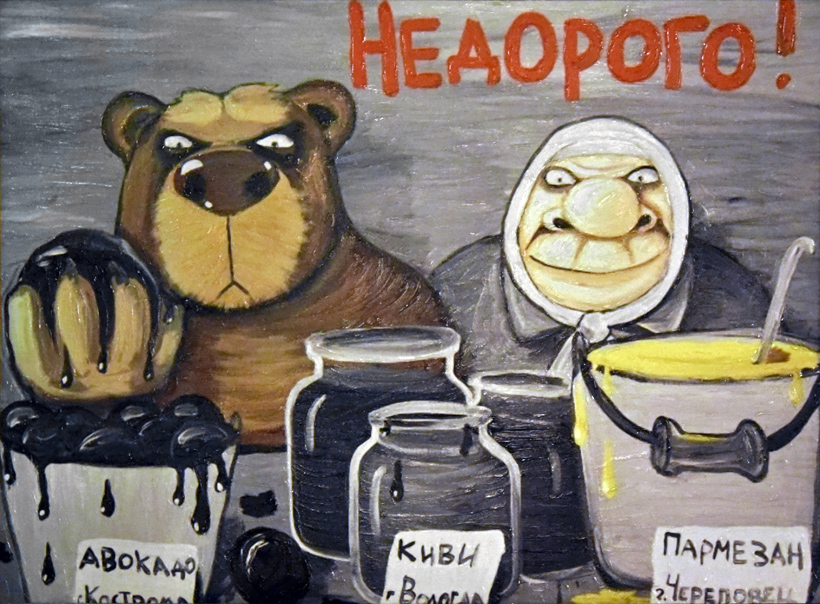
Pirogi Vino i Gus
Pirogi Vino i Gus means “Pies, Wine and Goose,” and this is exactly what you’ll find on the menu. As someone who enjoys eating goose, a bird that’s rarely found in restaurants or stores and presents a few cooking challenges, I like the idea. I’ve got nothing against pies and wine either! Their website promises to deliver: “we have the best pies, the best wine, and, of course, the most interesting and tasty goose dishes.” The chef, Alexander Zhurkin, is originally from Southern Russia, and has run the kitchens of many restaurants across the country, serving cuisines ranging from Central Asian and Russian to Italian. No wonder, then, that he claims his style “has no borders, covers cities and countries, rivers and oceans, forests and mountains, is thoughtful or fast, weary or impatient, sometimes modest, then proud, sometimes strict, then cheerful.” As we’ll see, this results in a somewhat confusing menu.
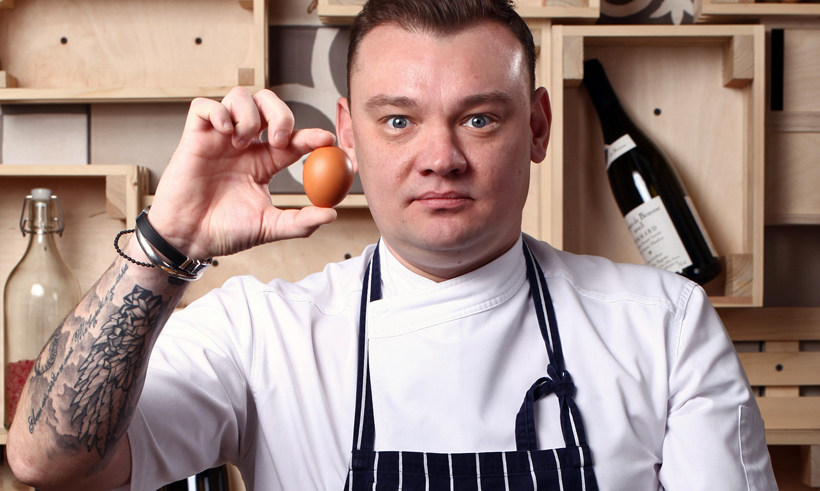
At Pirogi Vino i Gus, the word “pie” has to be taken in a broad sense. We’re mostly talking about savory pies, and they come in various sizes, shapes, and dough types – strudels, pirzhoki, rasstegai, round, oval, oblong, open-faced, closed – with the only common denominator being the presence of dough. You can get 16 different kinds, many of them quite original: cabbage, called kapustnik; veal Stroganoff, with porcini and gherkins; liver and cherries; goose and broccoli; curried poussin; mushrooms and cream; lamb and onion; rabbit satsivi; spinach and herbs; mozzarella, gouda, and tvorog; cod and carrot; eggplant and peppers; duck and pear; apple, nuts, and raisins; caramelized apple; cherry plum, apricot, and peach.
Then there are two or three “regular” menus (the layout is so unclear I’m not quite sure what’s going on). Some pages claim to present dishes that are best eaten with wine, others mention the history of the Black Sea and emphasize ingredients from that region, and others are just kind of… there. If you put everything together, you get a cross between a French brasserie, an Italian café, and a contemporary Russian restaurant, with some other random international notes. But let’s focus on the star of the show, goose. It appears in many dishes across the menus (except in desserts): scallop salad with smoked goose and passion fruit; Russian salad with goose (reminds me of my own Salad Olivier with duck breast and duck confit); goose liver soup with fried oyster; cheesy cream soup with smoked goose; goose leg confit with fried lettuce and orange sauce; gooseburger with avocado mousse, mozzarella, and French fries; baked goose with apples, spelt, and celery root sauce; goose fricassée with mushrooms and spinach; fettuccine with smoked goose, sun-dried tomatoes, mozzarella, and basil sauce. And if you prefer the goose’s smaller cousin: duck rillettes with lingonberry marmalade; duck breast with cherry-pomegranate sauce and quince purée. Just like with the pirogi, you get both classic recipes and some pretty interesting creations. I’ll wrap up the list with a special mention for two other original dishes: hare kidneys with porcini; pelmeni with (beef?) tongue and crawfish tails in a wine cream sauce.
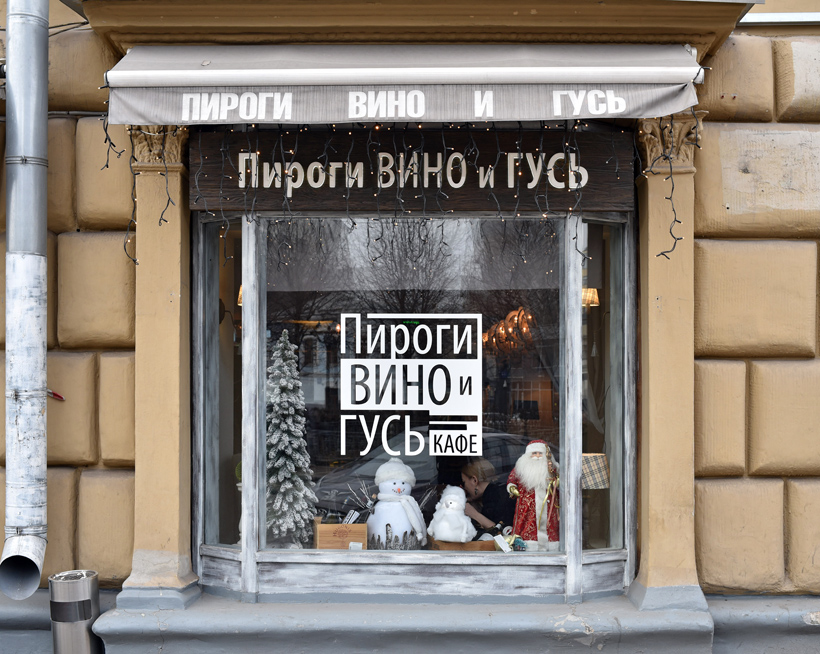
Let’s dig into a couple of pies / pirogi. The duck and pear pirog (“tender duck meat with flavorful pear”) is shaped like a small round pie. The duck and pear, chopped into small pieces, taste good but could use a little bit more seasoning and spices, especially since there’s quite a lot of dough altogether, and it tends to absorb some of the flavors of the filling. The dough itself is a fairly traditional pirozhki dough, more soft than crunchy, with a hint of sweetness.
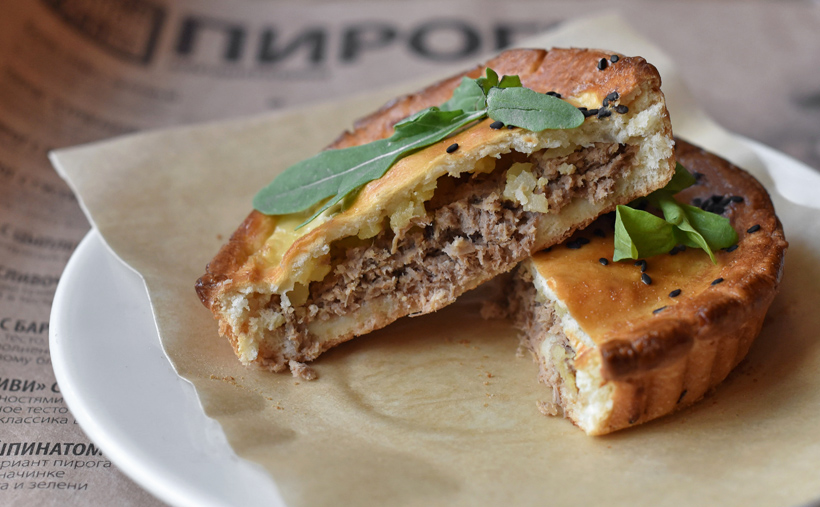
The rabbit satsivi pirog (“rabbit stewed with spices”… “unforgettable classic in a pirog“) has a very elongated shape, so here again there’s a lot of dough and the meat needs more seasoning and spices, especially since rabbit has a very delicate flavor to start with. I think the satsivi is a nice idea, though.
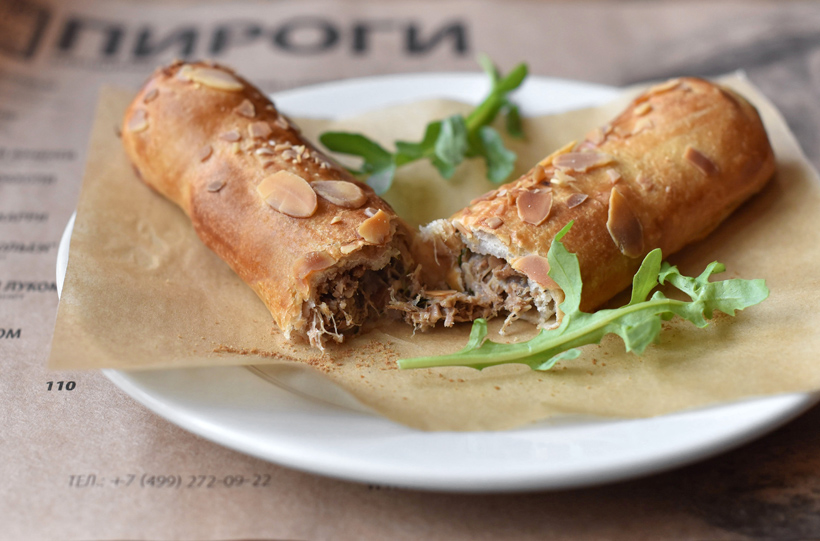
The gooseburger with avocado mousse, mozzarella, and fries arrived medium rare as ordered. Too bad, however, that the bun is complete cold! This is probably the first time I’ve eaten a burger with a goose patty! Ground goose meat has less flavor than, say, a whole roasted bird, but it’s tender and pretty good. Maybe it would have been better to use classic goose pairings as burger toppings, as they’d reinforce the goose flavor by association.
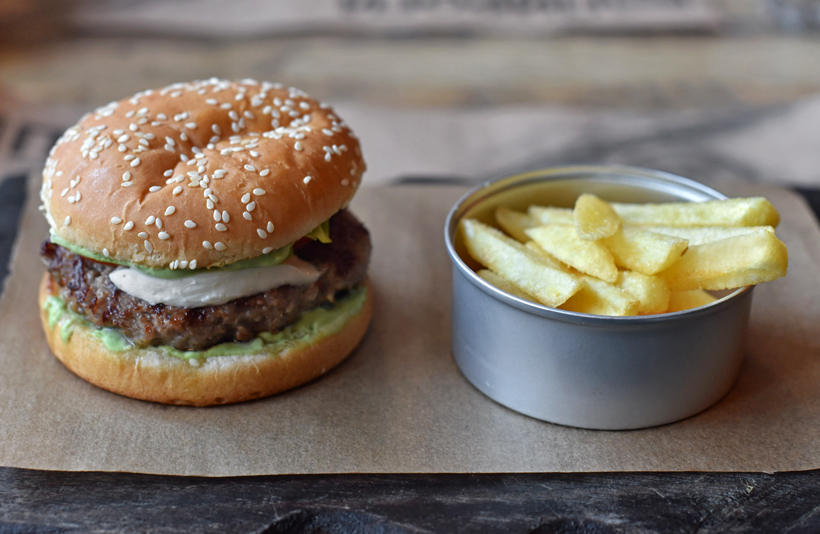
We get some of those classic pairings in the roasted goose with apples, spelt, and celery root sauce. The dish consist of a couple of small pieces of goose (probably from the thigh) and the skin brushed with something sweet, resting on a bed of spelt and celery root purée, and topped with a piece of roasted apple. The meat is very tender and very well cooked, and the creamy spelt is a good variation on kasha. This is a dish that measures up to the restaurant’s ambitions.

On the wine front, the extensive list, curated by sommelier Anton Panasenko, has received several awards, in particular for its selection of Russian wines and its selection of wines by the glass. The wines are also sold at very reasonable prices, making Pirogi Vino i Gus an excellent wine bar. I only tried one glass, the full-bodied Alma Valley 2014 Shiraz Reserve from Crimea, but it’s one of the best wines I drank during my entire trip.
Should you need another reason to go to Pirogi Vino i Gus, they now serve caviar (farm-raised ossetra from the Amur River or from Astrakhan) at unbeatable retail prices. And we’re not talking about 5 gram portions on dwarf blinis, but tins of 50, 125, or 250 grams! Paired with the excellent wine list, I think this is an opportunity for a memorable meal.
Overall, even if the execution sometimes needs tweaking, there are some interesting ideas and a unique identity at Pirogi Vino i Gus, in a comfy setting with affordable prices.
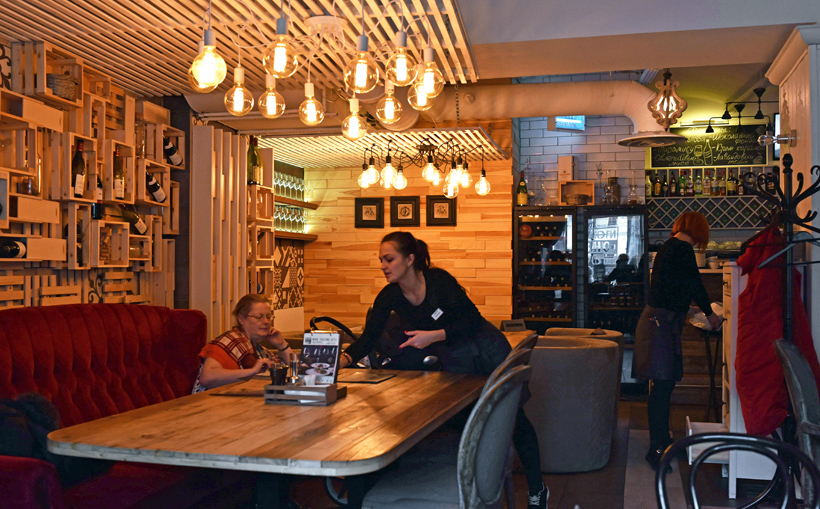
Russian Pub
If you’re imagining a long bar counter with loud people watching sports on TV while downing pint after pint, look elsewhere. While Russian Pub does have a bar and plenty of beers, it defines itself as a gastropub. Says their website: “We were eager to integrate Russian cuisine and craft alcohol with the interior and the atmosphere of a British pub, only seen from a more contemporary Russian angle. We did not neglect English traditions, but adapted them to our culture, filling a traditional English pie with Stroganoff meat, and making burgers, the most popular meal of any bar, with salo (cured pork fat).” Russian Pub is a literal illustration of the claim I made earlier that the gastrocafé is an evolution of the humble post-Soviet eatery with Russian home cooking. Again from the website: “Coming up with the concept of the project, we proceeded from the fact that for many years in post-soviet times, there was a small restaurant with traditional Russian cuisine, affordable prices and homely atmosphere, located in this exact building.”

Behind this project are two characters who, based on their online images, kind of look more like Brooklyn hipsters than actual Muscovites – judge for yourself from the pictures below.
Chef Alex Semenov knocked around Europe, studying at cooking schools in Spain, Italy, and France. Before this new venture, he worked in various Moscow restaurants whose modest level seems at odds with the adjective “famous” that almost invariably qualifies his name in articles online. For Russian Pub, Semenov created a cuisine that “is extremely close to Russian traditions, only slightly altered by modern tendencies and non-trivial combinations.” Like any self-respecting hipster, he chose an ax as his mascot, but the meaning is much deeper than we ill-spirited mockers might think: “In the symbol of the ax lies all our cuisine. […] [Both our cuisine and the ax] depend on which hands they’re placed into. Given an ax, one may chop down wood and build a house without a single nail, but another won’t know how to chop even firewood. We periodically chop cakes and piglets with this ax, it has become an attribute of our every holiday. Moreover, our ax is also a symbol of the continuity of generations – it is more than a hundred years old. It is a symbol of the wisdom of our ancestors.”
Teaming with Semenov on the liquid front is bartender/mixologist Max Bradarski, who must be a hipster by birth, since his last name, of Bulgarian origin, means “bearded.” Unlike Semenov, Bradarski is actually famous, which grants him the right to wear a chef’s jacket with great seriousness. Not only has he won several high-profile international cocktail contests, he also holds a world record for the simultaneous serving of cocktails out of 57 shakers (picture here), and excels at the kind of tomfoolery that Tom Cruise showed off in the movie Cocktail.

Alex Semenov (Photo: Russian Pub) 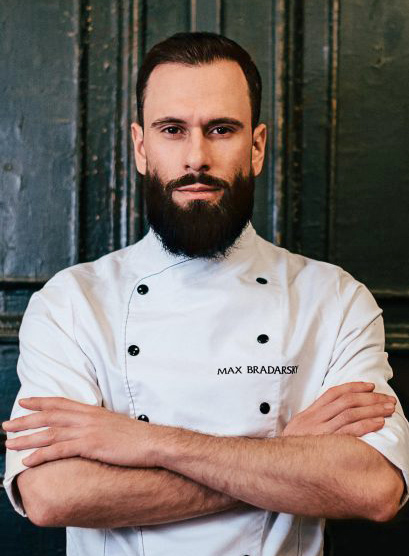
Max Bradarsky (Photo: Russian Pub)
The menu at Russian Pub emphasizes Russian ingredients, often prepared with a twist: cabbage, beet, eggplant, mushrooms, herring, cod, pike, salmon, muksun, rapana, duck, chicken, pork, buckwheat, barley… Sure, you’ll find them in the usual appetizers (salo, pickles) salads (salad Olivier, vinegret, potato salads), soups (borscht, cream soups), and main courses (cutlets, kasha). But there are more unexpected dishes too: Black Sea stroganina (a Siberian dish where delicious fish is served frozen for no good reason); Belarusian shrimp with Japanese horseradish (reminder: Belarus is a landlocked country); cod and calamari Orly (Orly, whose connection to the Paris airport is doubtful, just means fried in batter); mac and cheese with rapana and Druzhba (a spreadable cheese dating from Soviet times), pie Stroganoff, lamb tongues with pearl barley in beet juice; duck breast with apples and cranberry sauce.
Then there’s a few sections that cater to special interests. Such as the unusual list of buterbrody, or open-faced sandwiches, that reads like the gourmet version of the buffet counter at a Soviet train station. Choose between: vegetable caviar and eggplant cream, cod liver with eggs, forshmak, corned beef, sprat, and game pâté (this one supposedly shaped like an eclair). According to the chef, they’re the perfect accompaniment to a shot of vodka. The selection of pelmeni and vareniki is less surprising, and you have five options: rapana, three meats, lamb, game, potato-mushroom. FYI, Semenov claims to have embarked on a personal journey to make the best pelmeni, so they might be worth trying. Finally, the burgers: a pike burger, the Chef’s Burger (beef, I assume), a burger with pastrami, and a (vegetarian?) vinegret burger.

Start the meal off right, with a shot. A shot and a scoop of ice cream, it turns out! Inconspicuously listed with other vodkas, the Borschevka Gastronomical is the latest and greatest thing in vodka marketing. It has special properties, you see: “it advantageously reveals and emphasizes the taste of Russian dishes,” “whets the appetite,” and “contributes to the full digestion of food.” Its secret lies in the preparation. First, traditional Russian vegetables, herbs, and spices (including cabbage, garlic, bay leaf, and pepper) are macerated in a mix of alcohol and water for several days. Then, the flavored alcohol is distilled in a copper still, and then filtered. To simplify, it’s like gin but with cabbage instead of juniper. It comes in three versions, differing in the ingredients used in the maceration: original, cold spices, hot spices. Needless to say, Semenov recommends drinking this vodka from his ax.
The original Borschevka is supposed to exhibit “a soft and clean taste of rye bread, cabbage notes, a light and harmonious aftertaste of bay leaf, pepper and garlic.” I had not heard all that when I tried it, but I would agree it has a mild and well-blended nose of spices (I thought I detected coriander), which makes it pleasant to drink. The ice cream on the side turns out to be silky-smooth borscht ice cream, in which I clearly taste the cabbage and beet. There might actually be some truth to the marketing mumbo-jumbo, as it’s a great pairing with the Borschevka!

Just in time to go with the vodka, the sandwich with corned beef proves to be more elaborate than its simple name suggests. Slices of hearty rye bread are spread with mayonnaise and topped with eggplant, red pepper, and finally roast beef, with a piece of hot pepper on top.
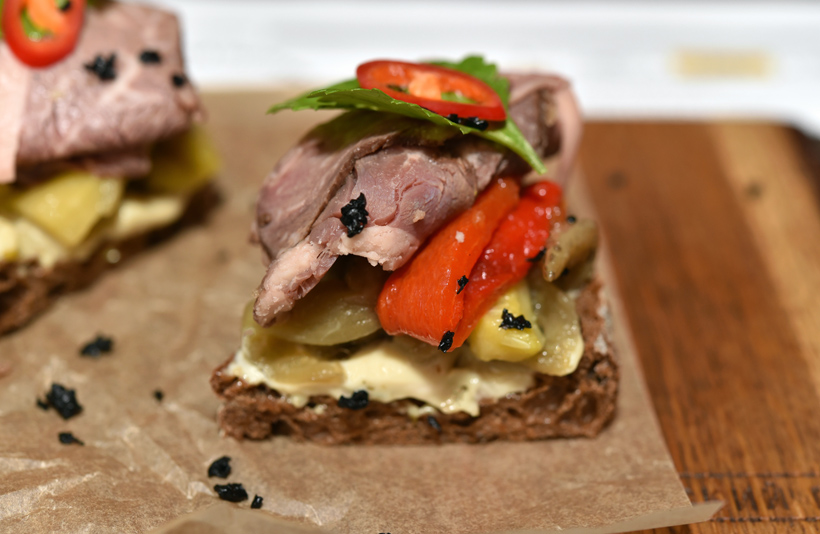
The game pâté is a kind of DIY toasty. Take toasted rye bread, and spread with pâté (whose texture is more like a mousse, as was the case with some of the pâtés at Chemodan). Then garnish with lingonberry jelly, almonds, and herbs. Don’t forget to serve on parchment paper.

The wild mushroom cream soup is pretty simple, but it really tastes of mushrooms and has the right texture.

The pumpkin cream soup is just as well-made but rather more interesting, as it has pine nuts and chunks of salmon. The menu also mentions chervil pesto, but I don’t remember seeing or tasting it.

The muksun with barley and vegetable risotto is a great way to prepare this Siberian fish. The barley risotto, with carrots and onions, has the perfect texture and discreetly complements the muksun. It’s not a very complicated dish, but I would gladly try it with trout or salmon at home.
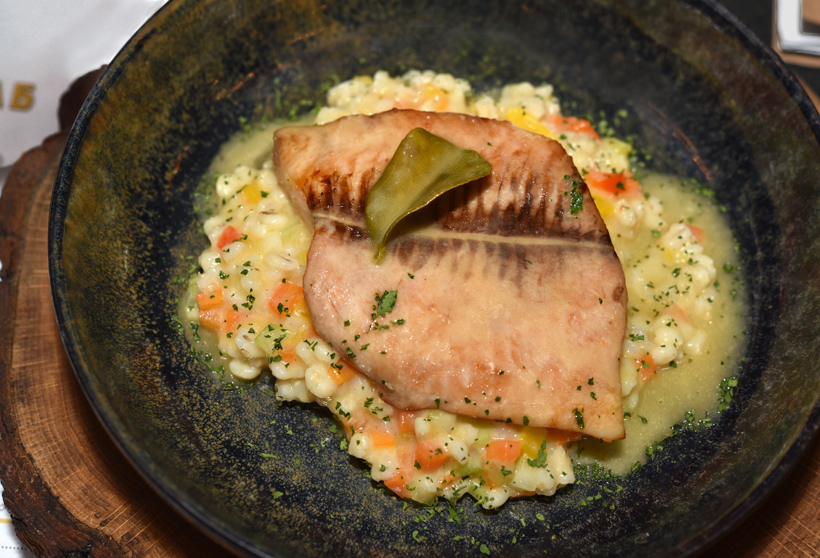
The Stroganoff pie is a Russian twist on a pub classic… or maybe a pub twist on a Russian classic! It’s exactly a beef Stroganoff with crust on top, but a well-made Stroganoff, with onion, mushroom, cream, and tiny chunks of beef cooked for a long time, on a bed of potato purée. The individual pie makes for a copious serving.
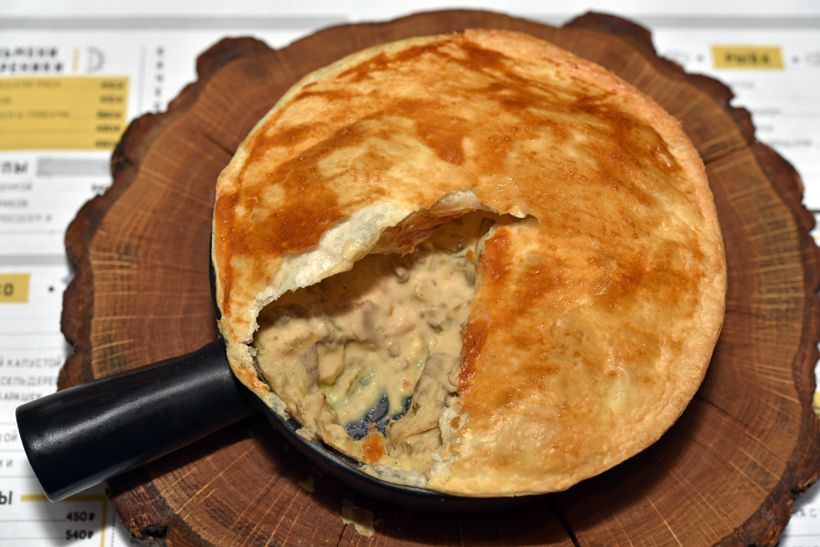
Russian Pub offers a good selection of Russian and Soviet desserts, including medovik (layered honey cake), chocolate sausage (a Soviet classic), and apple sharlotka. I’m also glad to see the pavlova, after its Australian (or New Zealander, or American, or German?) inception, finally returning to its spiritual home. The meringue dome and berry coulis don’t disappoint.
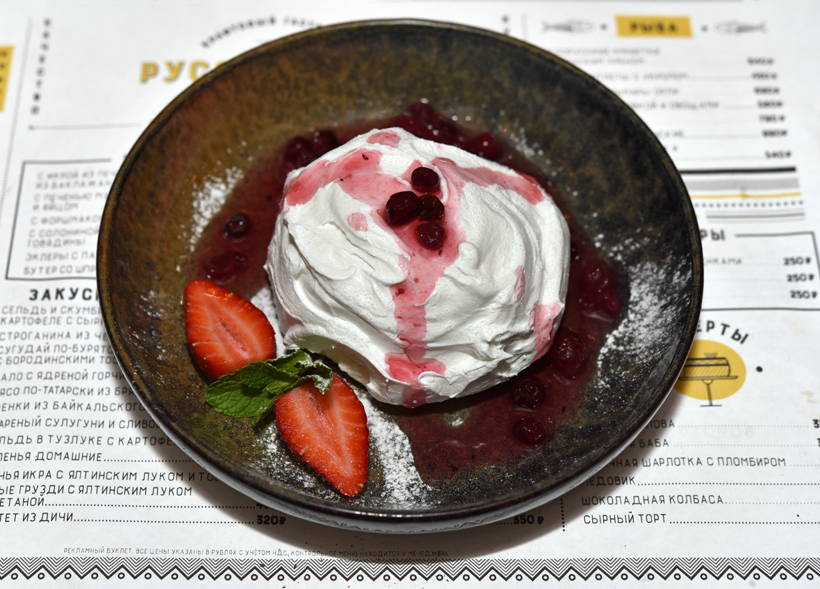
Going back to the alcoholic beverages, we’re told that our man Max Bradarsky “takes the beer menu pretty seriously, having tried approximately 200 beer types, but selecting only 20 bottle and 8 tap craft beer options for the menu.” He also makes over a dozen flavored vodkas, from the classic horseradish, pepper, or lemon, to the more unusual beet, pine nut, basil-lemon, or sea-buckthorn, to the obscure krambambulya (a Belarusian recipe made with honey and spices). Finally, there are about 25 types of red, white, rosé, and sparkling wines, all made in Russia. The Dostoyny Premium turns out to be just okay; not bad but not very interesting. But hey, when you pick the cheapest bottle on the menu, you get what you pay for!
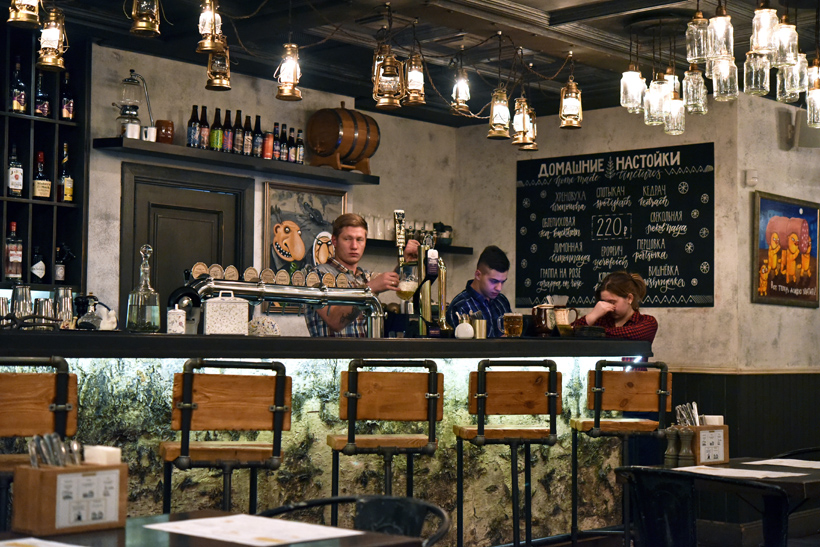
I’d love to go back to Russian Pub with my best bearded friends to taste the perfect pelmeni, sip a cocktail prepared by a Guinness record holder, and try another shot or two of that Borshevka. Maybe Semenov could even show us his legendary ax. As long as he cleans it between chopping piglets and cutting slices of cake…


1 comment
i want to try it